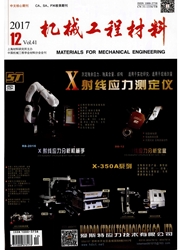

 中文摘要:
中文摘要:
利用共聚焦激光显微镜原位观察了普通低碳钢和含钒低碳钢在三种不同冷速下(0.17,1,10℃·s-1)的δ→γ相变过程,分析了含钒低碳钢的δ→γ相变特点以及冷速和钒对δ→γ相变的影响。结果表明:随冷却速率的提高,含钒低碳钢的δ→γ相变所需过冷度增加,相变起始和终了温度降低;当冷速较低时,γ相依次在δ-Fe晶界三叉点和晶界形核,最后缓慢在晶内形核;当冷速较高时,γ相在δ-Fe晶界三叉点和晶界处几乎同时形核,之后迅速在晶内形核;钒可以抑制δ-Fe晶界三叉点的迁移,扩大δ→γ相变的温度范围,延长相变时间。
 英文摘要:
英文摘要:
The phase transformation of delta-ferrite to austenite(δ→γ)in low carbon steel and vanadium micro-alloyed low carbon steel was in-situ observed utilizing confocal scanning laser microscope at three different cooling rates(0.17,1,10 ℃·s-1).The characteristics ofδ→γphase transformation in vanadium micro-alloyed low carbon steel at various cooling rates and the effects of cooling rate and vanadium were analyzed.The results show that the undercooling rose and the starting and ending temperatures dropped with the increase of cooling rate.At a low cooling rate,theγphase nucleated prior at the triple points ofδ-Fe,then atδ-Fe grain boundaries,finally nucleated in grains.At a high cooling rate,γphase nucleated prior at the triple points ofδ-Fe andδ-Fe grain boundaries almost simultaneously,then nucleated in grains quickly.The element vanadium can inhibit the movement of the triple points ofδ-Fe,expand temperature range and prolong duration ofδ→γphase transformation.
 同期刊论文项目
同期刊论文项目
 同项目期刊论文
同项目期刊论文
 Influence of Ar-ions irradiation on the oxidation behavior of ferritic-martensitic steel P92 in supe
Influence of Ar-ions irradiation on the oxidation behavior of ferritic-martensitic steel P92 in supe Effect of stress on microstructural evolution and mechanical properties of 12Cr3W3Co steel during ag
Effect of stress on microstructural evolution and mechanical properties of 12Cr3W3Co steel during ag Microstructural Evolution of Delta Ferrite in SAVE12 Steel under Heat Treatment and Short-term Creep
Microstructural Evolution of Delta Ferrite in SAVE12 Steel under Heat Treatment and Short-term Creep 期刊信息
期刊信息
